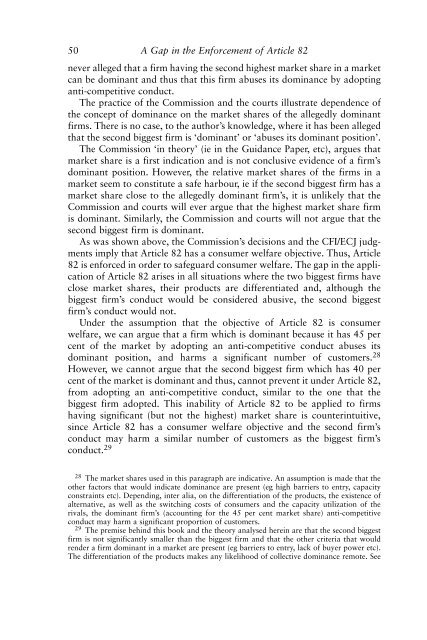Abuse of Economic Dependence - The Centre for European Policy ...
Abuse of Economic Dependence - The Centre for European Policy ...
Abuse of Economic Dependence - The Centre for European Policy ...
Create successful ePaper yourself
Turn your PDF publications into a flip-book with our unique Google optimized e-Paper software.
50 A Gap in the En<strong>for</strong>cement <strong>of</strong> Article 82<br />
never alleged that a firm having the second highest market share in a market<br />
can be dominant and thus that this firm abuses its dominance by adopting<br />
anti-competitive conduct.<br />
<strong>The</strong> practice <strong>of</strong> the Commission and the courts illustrate dependence <strong>of</strong><br />
the concept <strong>of</strong> dominance on the market shares <strong>of</strong> the allegedly dominant<br />
firms. <strong>The</strong>re is no case, to the author’s knowledge, where it has been alleged<br />
that the second biggest firm is ‘dominant’ or ‘abuses its dominant position’.<br />
<strong>The</strong> Commission ‘in theory’ (ie in the Guidance Paper, etc), argues that<br />
market share is a first indication and is not conclusive evidence <strong>of</strong> a firm’s<br />
dominant position. However, the relative market shares <strong>of</strong> the firms in a<br />
market seem to constitute a safe harbour, ie if the second biggest firm has a<br />
market share close to the allegedly dominant firm’s, it is unlikely that the<br />
Commission and courts will ever argue that the highest market share firm<br />
is dominant. Similarly, the Commission and courts will not argue that the<br />
second biggest firm is dominant.<br />
As was shown above, the Commission’s decisions and the CFI/ECJ judgments<br />
imply that Article 82 has a consumer welfare objective. Thus, Article<br />
82 is en<strong>for</strong>ced in order to safeguard consumer welfare. <strong>The</strong> gap in the application<br />
<strong>of</strong> Article 82 arises in all situations where the two biggest firms have<br />
close market shares, their products are differentiated and, although the<br />
biggest firm’s conduct would be considered abusive, the second biggest<br />
firm’s conduct would not.<br />
Under the assumption that the objective <strong>of</strong> Article 82 is consumer<br />
welfare, we can argue that a firm which is dominant because it has 45 per<br />
cent <strong>of</strong> the market by adopting an anti-competitive conduct abuses its<br />
dominant position, and harms a significant number <strong>of</strong> customers. 28<br />
However, we cannot argue that the second biggest firm which has 40 per<br />
cent <strong>of</strong> the market is dominant and thus, cannot prevent it under Article 82,<br />
from adopting an anti-competitive conduct, similar to the one that the<br />
biggest firm adopted. This inability <strong>of</strong> Article 82 to be applied to firms<br />
having significant (but not the highest) market share is counterintuitive,<br />
since Article 82 has a consumer welfare objective and the second firm’s<br />
conduct may harm a similar number <strong>of</strong> customers as the biggest firm’s<br />
conduct. 29<br />
28 <strong>The</strong> market shares used in this paragraph are indicative. An assumption is made that the<br />
other factors that would indicate dominance are present (eg high barriers to entry, capacity<br />
constraints etc). Depending, inter alia, on the differentiation <strong>of</strong> the products, the existence <strong>of</strong><br />
alternative, as well as the switching costs <strong>of</strong> consumers and the capacity utilization <strong>of</strong> the<br />
rivals, the dominant firm’s (accounting <strong>for</strong> the 45 per cent market share) anti-competitive<br />
conduct may harm a significant proportion <strong>of</strong> customers.<br />
29 <strong>The</strong> premise behind this book and the theory analysed herein are that the second biggest<br />
firm is not significantly smaller than the biggest firm and that the other criteria that would<br />
render a firm dominant in a market are present (eg barriers to entry, lack <strong>of</strong> buyer power etc).<br />
<strong>The</strong> differentiation <strong>of</strong> the products makes any likelihood <strong>of</strong> collective dominance remote. See


